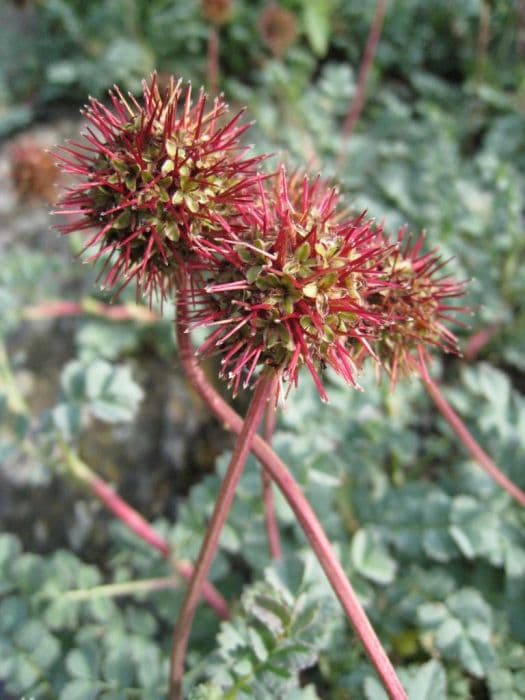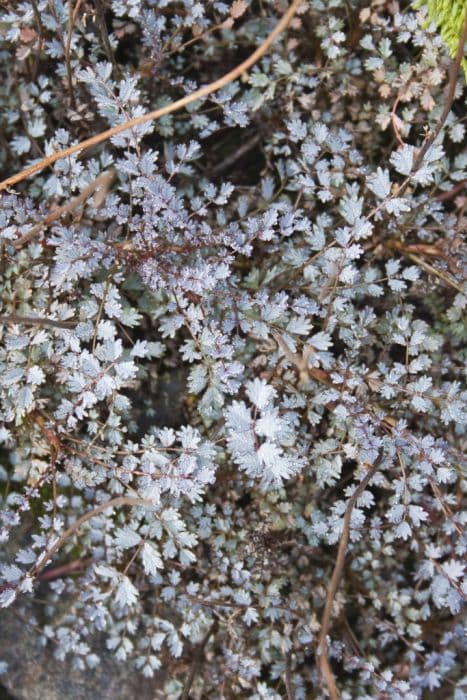Weeping Higan cherry Prunus pendula f. ascendens 'Rosea'

ABOUT
The plant known as the weeping cherry is a captivating ornamental variety, celebrated for its elegant and graceful aspect. Its branches cascade downwards in a delicate sweep, creating a fountain-like effect that is pleasing to the eye. During the blooming season, the weeping cherry is adorned with a profusion of pink flowers that add a romantic touch to any landscape. These flowers provide a vibrant splash of color, transforming the plant into a focal point of blossoming beauty. The leaves of the weeping cherry are small to medium in size and have a fresh, green hue that complements the floral display. With the changing of the seasons, the foliage undergoes a transformation, showcasing a range of colors from green to yellow, and often to warm shades of orange and red. Overall, the weeping cherry presents a harmonious blend of color and form that is both aesthetically pleasing and soothing to behold.
About this plant
 Names
NamesSynonyms
Ascending Rosebud Cherry, Weeping Higan Cherry, Spring Cherry.
Common names
Prunus pendula 'Rosea', Prunus serrulata 'Rosea', Cerasus pendula 'Rosea'.
 Toxicity
ToxicityTo humans
The plant in question is commonly known as the Weeping Higan cherry. It belongs to the genus Prunus, which includes many trees and shrubs that can produce compounds that are toxic to humans. The seeds, leaves, and stems of Prunus species can contain cyanogenic glycosides, which can release cyanide when ingested. If parts of the Weeping Higan cherry containing these compounds are consumed, cyanide poisoning could occur. Symptoms of cyanide poisoning include headache, dizziness, confusion, shortness of breath, and potentially can lead to more severe symptoms such as convulsions, respiratory failure, and even death. It is important for humans to avoid ingesting any parts of this plant.
To pets
The Weeping Higan cherry, which is a variety of ornamental cherry tree, is also potentially toxic to pets such as dogs and cats. The plant is part of the Prunus genus, and like with humans, the seeds, leaves, and stems can contain cyanogenic glycosides. If ingested by pets, these glycosides can lead to cyanide poisoning. Symptoms of poisoning in pets might include dilated pupils, difficulty breathing, panting, and shock, which could potentially be fatal. Therefore, it is essential to prevent pets from ingesting parts of this plant to avoid the risk of toxicity.
 Characteristics
CharacteristicsLife cycle
Perennials
Foliage type
Deciduous
Color of leaves
Green
Flower color
Pink
Height
15-25 feet (4.6-7.6 meters)
Spread
15-25 feet (4.6-7.6 meters)
Plant type
Tree
Hardiness zones
5
Native area
Asia
Benefits
 General Benefits
General Benefits- Aesthetic Appeal: Produces beautiful pink blossoms that enhance the visual appeal of landscapes during spring.
- Habitat Support: Offers food and shelter for various species of birds and insects through its flowers, leaves, and structure.
- Shade Provider: Can offer a gentle shade, making it suitable for planting in gardens and parks where light shading is desired.
- Seasonal Interest: Offers seasonal changes in appearance, from spring blossoms to autumn leaf colors, increasing year-round interest in the garden.
- Urban Tolerance: Adapts well to urban conditions, tolerating pollution and confined soil spaces, which makes it suitable for city environments.
- Cultural Significance: Often used in festivals and celebrations, particularly in cherry blossom viewings, adding cultural and traditional value.
- Erosion Control: Its root system can help stabilize the soil and prevent erosion on slopes or in areas prone to soil degradation.
- Wildlife Forage: The plant provides nectar and pollen for bees and other pollinators, contributing to the health of these essential species.
- Compact Size: Due to its relatively small size and controlled growth habit, it is suitable for small gardens and landscapes with limited space.
- Low Maintenance: Requires minimal pruning and care once established, making it a convenient choice for gardeners of all skill levels.
 Medical Properties
Medical PropertiesThis plant is not used for medical purposes.
 Air-purifying Qualities
Air-purifying QualitiesThis plant is not specifically known for air purifying qualities.
 Other Uses
Other Uses- Woodworking: The wood of Prunus pendula 'Rosea', also known as Weeping Higan Cherry, can be used in the creation of furniture or in wood carving due to its durability and grain patterns.
- Crafting Natural Dyes: The bark and leaves may be used to extract natural dyes for fabric or artwork, giving a range of colors from pale yellow to deep rust.
- Photography Subject: With its picturesque blossoms, it serves as a popular subject for photographers, especially during the spring bloom.
- Landscape Painting: Artists often utilize the beauty of Weeping Higan Cherry trees as inspiration or direct subjects in landscape paintings.
- Bonsai Art: Though not the most common species, it can be trained into a bonsai form, revered for its elegant flowers and form.
- Educational Tool: Schools and universities might use the tree to teach students about plant biology, particularly the life cycle of cherries and flowering trees.
- Culinary Experiments: While not common, the blossoms and leaves, if free from pesticides, could be used to infuse or flavor delicate desserts or teas.
- Wedding Decorations: The branches and flowers can be incorporated into wedding décor, especially for spring ceremonies, adding a natural and romantic touch.
- Horticultural Competitions: Gardeners may cultivate Weeping Higan Cherry trees for entry into tree-shaping or floral display contests.
- Floral Arrangements: Branches with blossoms are often used in large, ornate floral arrangements or as a standalone feature in ikebana, the Japanese art of flower arrangement.
Interesting Facts
 Feng Shui
Feng ShuiThe Weeping Higan Cherry is not used in Feng Shui practice.
 Zodiac Sign Compitability
Zodiac Sign CompitabilityThe Weeping Higan Cherry is not used in astrology practice.
 Plant Symbolism
Plant Symbolism- Beauty - The Prunus pendula f. ascendens 'Rosea', commonly known as the Weeping Cherry, is renowned for its stunning pink blossoms, symbolizing beauty and the aesthetic pleasures in life.
- Transience - As a cherry blossom variety, the Weeping Cherry represents the fleeting nature of life, a concept deeply rooted in Japanese culture where cherry blossoms, or sakura, are celebrated for their short but brilliant blooming season.
- Purity - The delicate and pure appearance of the tree's flowers often symbolizes innocence and purity.
- Renewal - Blooming in the spring, the Weeping Cherry symbolizes new beginnings and the rejuvenation of nature, reflecting the cycle of life.
- Mindfulness - The sakura's brief bloom period encourages people to be present and appreciate the current moment, which aligns with the practice of mindfulness.
 Water
WaterFor the Weeping Higan Cherry, it is crucial to maintain consistent soil moisture without waterlogging. Water the tree deeply once a week, providing about 15 to 20 gallons each time for established trees to ensure proper hydration of the root zone. In the absence of rainfall, this weekly watering should continue. During hot, dry periods, increase the frequency to twice a week. For younger trees in their first couple of years, water them twice a week with about 10 gallons each time to support their developing root systems.
 Light
LightThe Weeping Higan Cherry thrives in full sun, which means it needs at least 6 to 8 hours of direct sunlight per day. It is best planted in a spot where it can receive unfiltered sunlight throughout the day, avoiding shaded areas to ensure ample light for healthy growth and blooming.
 Temperature
TemperatureThe Weeping Higan Cherry does well in a range of temperature conditions and is hardy from USDA zones 5 through 8. It can handle temperatures as low as -20 to -10 degrees Fahrenheit but performs best when the temperature ranges between 30 and 85 degrees Fahrenheit. Extreme heat above 90 degrees Fahrenheit may stress the tree, requiring additional care.
 Pruning
PruningPrune the Weeping Higan Cherry for shape, health, and clearance in late winter or early spring before the new growth starts. Remove any dead, diseased, or crossing branches to maintain a strong structure. Pruning should be done yearly, focusing on thinning to allow light into the canopy which encourages blooming and prevents disease.
 Cleaning
CleaningAs needed
 Soil
SoilWeeping Higan Cherry prefers a well-draining and fertile soil mix with a pH of 6.0-7.5. A mix of loam, organic compost, and sand in equal parts is optimal to provide the necessary nutrients and aeration.
 Repotting
RepottingThe Weeping Higan Cherry, being a large landscape tree, does not require repotting as it is typically not grown in containers.
 Humidity & Misting
Humidity & MistingThe Weeping Higan Cherry thrives in moderate ambient humidity, typical of outdoor environments, without specific humidity requirements.
 Suitable locations
Suitable locationsIndoor
Can't grow Weeping Higan Cherry indoors; it's a large tree.
Outdoor
Plant in full sun, ensure fertile, moist, well-draining soil.
Hardiness zone
5-8 USDA
 Life cycle
Life cyclePrunus pendula f. ascendens 'Rosea', commonly known as the Ascending Pink Weeping Cherry, begins its life as a seed that germinates in spring, though many gardeners plant it as a young sapling. Upon germination or planting, it enters a vegetative growth stage where it develops a distinctive weeping form with branches that grow upward before arching down and then continues to expand its canopy with green leaves each spring. In its reproductive stage, usually starting around the third or fourth year, the tree produces clusters of pink flowers in early spring before leaf emergence. After pollination by insects, these flowers eventually give way to small inedible fruits that are primarily disseminated by animals. The tree continues to grow and can reach up to 25 feet tall, experiencing cycles of flowering and fruiting annually. As it matures, the Ascending Pink Weeping Cherry enters a phase of senescence, which, under optimal conditions, may not occur until the tree is 15-20 years old, with the entire lifespan potentially extending 30 years or more with proper care.
 Propogation
PropogationPropogation time
Spring
The Weeping Higan Cherry (Prunus pendula f. ascendens 'Rosea') is commonly propagated by grafting, a technique which joins the tissues of one plant to those of another. This method is usually performed in late winter or early spring, before the sap starts to flow. Scion wood, which is a 4 to 6 inches long piece of a one-year-old branch of the desired cultivar, is carefully selected and cut. The scion is then joined to a rootstock, which is a young tree or seedling, by making compatible cuts on both the scion and rootstock and securing them together. This is often done by making a slanted cut on each, binding them with grafting tape, and sealing with grafting wax to prevent desiccation. The process requires precision and care to ensure a tight fit that allows the vascular tissues of the two parts to grow together, eventually forming a successful and fruiting Weeping Higan Cherry tree.









